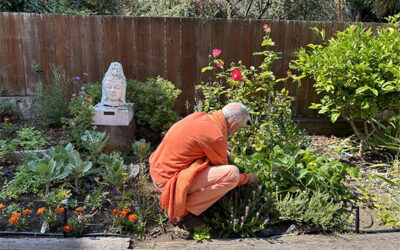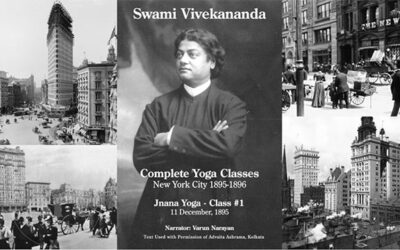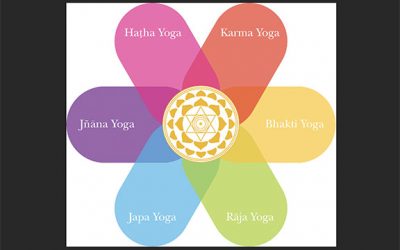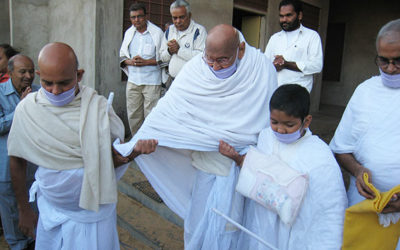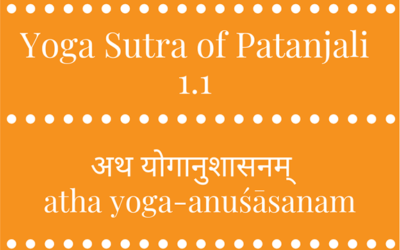Veganism and the Yamas: A Yogic Call to Compassion Yoga is a path of transformation—one that extends far beyond the mat. It is a way of living that aligns our thoughts, words, and actions with our highest ideals. The eight limbs of Raja Yoga, as outlined by Patanjali,...
Practice and Non-Attachment: A Two Pronged Approach to Liberation
If you want to see well through a window, you have to clean both sides. Practice (abhyasa) and non-attachment (vairagya) work much the same way. They are the complimentary practices given in Patanjali’s Yoga Sutras as a means to quiet the movement of thought in the...
Ishvara Pranidhana: The Psychology of Surrender
On the journey of self-growth, one of the central concepts in yogic philosophy is Ishvara Pranidhana, or the act of surrendering to a Higher Power. Patanjali, in the Yoga Sutras, describes it as a foundational practice that leads us toward liberation and inner peace....
VedantaWorks: The Teachings of Swami Vivekananda
VedantaWorks recently released their third podcast series: The Raja Yoga classes of Swami Vivekananda. VedantaWorks is dedicated to the teachings of Vedanta, the basic philosophy of Hinduism as expressed through Swami Vivekananda. Swami Vivekananda (1863-1902) was an...
Who Are You? Who Are You Being? Svadhyaya – “Self-Study”
Who am I really? Who am I being? These are two queries and discoveries to be made while practicing svadhyaya (self-study)—Yoga’s fourth niyama, as well as the second practice in the Kriya Yoga of Sri Patanjali. Svadhyaya includes the study of sacred texts and the...
Learning to Work Through Challenges: Tapas (Self-Discipline)
"God knows your breaking point. You simply don't know your own strength." –Swami Satchidananda How many times have you been a safe container for those you care about? What did it look like? What did it feel like? Challenging oneself to be disciplined or to attain a...
The Real Yoga
The essential teaching and goal of Yoga is to make the mind calm. “Yoga chitta vritti nirodha,” says the Yoga Sutras of Patanjali. That means that Yoga is the calming of the waves created in the chitta, the mind by keeping the mind balanced under all conditions. In...
The Integral Yoga System: A Quick Overview
The first thing I love about Yoga is that it’s something you can do when everything else out there is falling apart. I know this has brought many people to Yoga. It’s a way to assert your own power and control over your life, even when you seem powerless to change...
Questions and Answers on the Yamas
Q: In the Ramayana and Mahabharata, it’s clear that there was killing. The Gita itself takes place on a battlefield. How is this explained and justified in terms of ahimsa (non-violence)? Swami Satchidananda: In the Bhagavad Gita, Krishna talks about non‑violence to...
A Nondual Approach to the Niyamas
Retaining what we’ve learned about the yamas, we now train our attention on the niyamas which occur in sutra 2.32. When prefixed to a noun “ni” can be a negation. It also means “down, back, in, into, within.” Thus, niyama is traditionally rendered “observances”...
Light on the Yamas & Niyamas—Satya: What About Truth?
Satya, truth, stands second in Patanjali’s list of virtues or “restraints.” Most often rendered with respect to speech, like ahimsa, satya broadens to include thought and deed. Under the rubric of ahimsa, the commentators advocate that truth not be spoken unkindly,...
Light on the Yamas & Niyamas: Awakening to Ahimsa
In this column, Rev. Dale Ann Gray offers reflections on the yamas and niyamas of the Yoga Sutras, incorporating insights from classical Nondual Yoga. In this article, she unpacks the first yama, ahimsa (non-violence, non-harming). In the Yoga Sutras of Patanjali,...
Light on the Yamas & Niyamas: Introduction
In this new column, Dale Ann Gray offers reflections on the yamas and niyamas of the Yoga Sutras, incorporating insights from classical Nondual Yoga. In this article, she offers an overview on the distinctions between the dualistic philosophy of Patanjali’s Yoga and...
Raja Yoga Now: The Beginning
The Yoga Sutras of Patanjali begins with a call that reverberates through the ages: Atha Yoganusasanam: Now the exposition of Yoga is being made. It is an invitation to seekers of truth everywhere, irrespective of place, time or circumstance. It offers a universal...
Raja Yoga Now: The Master’s Touch
It was in September 1970 that I first met my spiritual master. It was a time when many great Gurus were being drawn to the West, attracted by the awakening aspiration of the youth. Several hundred of us had gathered at a rustic site in the mountains of California for...
Hatha Yoga: The Sadhana of Kali Yuga and Hatha’s Texts
The sages advised that since, in Kali Yuga, humankind is preoccupied with the body, an important sadhana or spiritual practice for this age is Hatha Yoga—the science of achieving higher consciousness through the disciplines of body and breath. In this article, the...


